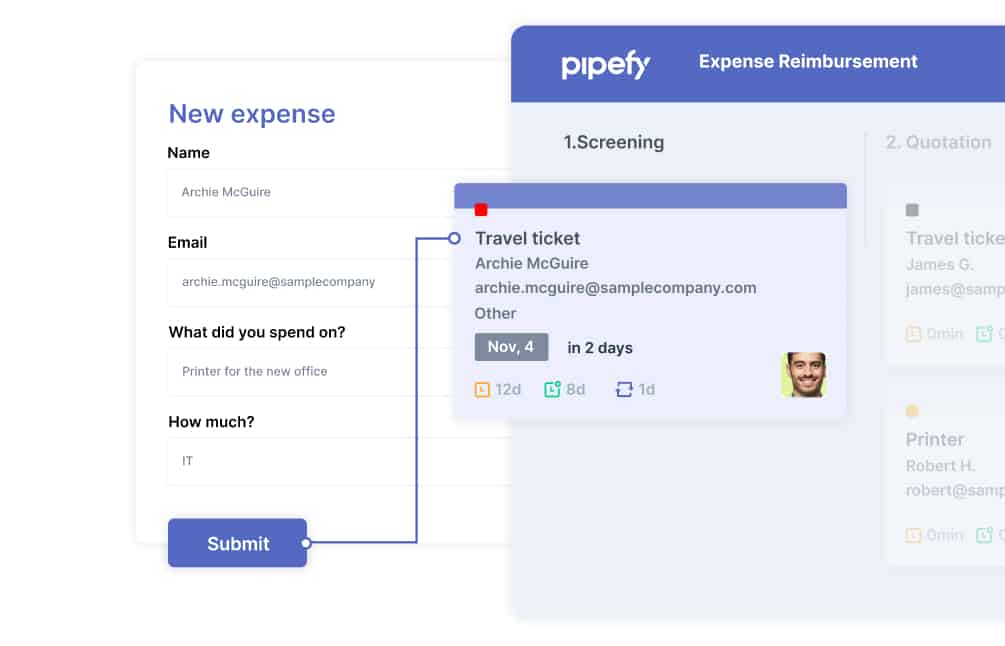ARTICLE SUMMARY
Understanding Reimbursement Expenses

Reimbursement is the act of businesses paying back employees, customers, or other parties for out-of-pocket expenses on behalf of the organization. Typically, people think of travel when it comes to reimbursement. In reality, there are several forms of reimbursement, including, but not limited to: education, medical, and other industry-specific reimbursements.
Often, organizations will also cover insurance costs and overpaid taxes to meet qualifications for tax-deductible expenses. According to the IRS, tax-deductible expenses must comply with the definition of an “accountable plan” and adhere to several other requirements.
3 types of expense reimbursement
There are many types of expense reimbursement, but the most common forms are: business, travel, and medical expense reimbursement.
Business expense reimbursements
Many employees sign up for continuing education classes at the encouragement of their boss. These classes are usually expensive and are exclusively meant to help employees improve their professional skill set. In these cases, companies will often reimburse the class fee.
This type of expense is called a “business expense”. Business expense reimbursements repay employees for activities or materials that improve their productivity at work. Some examples are: office supplies, role-specific training, or even meals with business partners and team members. These reimbursements are not considered wages and are non-taxable for the employee.
Travel reimbursement
Travel reimbursement is most often thought of when using the word “reimbursement”. On business trips, employees are paid per diem rates to pay for hotels, food, and transportation. Travel reimbursement can get expensive, so businesses enact policies to restrict employees to a range of airfare, hotel, and meal prices that they deem appropriate.
Sometimes employees attend conferences, events, or meetings in or around the city in which they live. In those cases, businesses reimburse employees for public transportation, or mileage and gas. In fact, the IRS even provides standard mileage rates when reimbursing employees for personal automobile travel.
Medical expense reimbursements
Many businesses grant medical insurance to their employees. Health insurance can be bestowed in the form of: Health Savings Accounts (HSA), Health Reimbursement Accounts (HRS), Flexible Spending Accounts (FSA), or simply a taxable stipend for health insurance. The tax benefits of each account or stipend vary, but each reimburses employees for health premiums and other qualified medical expenses.
Specifically, HSAs are employee-owned bank accounts that allow for tax-free medical expense reimbursement. Companies contribute an amount to employees’ HSAs at the beginning of the year or throughout the year. In addition, employees can contribute to their HSA account, tax-free. When a health issue or expense arises, employees can disburse HSA money to pay for health expenses. If employees do not use their account throughout the year, the balance carries over to cover medical costs in the following year.
HRAs also reimburse employee medical expenses tax-free with rollovers. However, they are paired with a high-deductible health plan or as a stand-alone benefit. FSAs are similar, but only permit employees to save for qualified medical expenses during a single year. Lastly, a few businesses offer a taxable allowance for health insurance of their employees’ choice.
Industry-specific reimbursements
Beyond business, travel, and medical reimbursement, some industries have very particular methods of issuing reimbursements.
Insurance industry reimbursement
Health insurance is a classic example of reimbursement. After a hospital or doctor’s visits, patients are billed for all charges including ambulance services, consultations, x-rays, and medication. Luckily, health insurance will pay you back for a portion of your healthcare expenses.
Some insurance providers cover the cost of emergency services (within the stipulations of the policyholders’ coverage) at the time of the expense. Other insurance companies require patients to cover their losses out-of-pocket before seeking reimbursement for the expenses that their policy covers.
Tax refunds
The tax returns you get in the spring are a form of reimbursement. Income taxpayers pay an amount of state and federal government taxes with every paycheck. These taxes do not account for credits a taxpayer could be entitled to as a result of expenditures or other taxes paid throughout the year. Consequently, the state and federal government may have to pay the taxpayer back the following year.
Legal sector reimbursements
Most people are familiar with the term alimony, which is a type of legal sector reimbursement. Alimony is ordered by a judge in court and compensates an ex-spouse for time and money invested in the other spouse’s financial prospects. For instance, let’s say your spouse worked full-time to put you through graduate school. If you get a divorce, he or she may be eligible for reimbursement alimony if you graduated and are earning income as a result of that education.
Setting reimbursement requirements
Of course, not everything should be reimbursed. To keep businesses financially healthy, companies enact policies for various types of reimbursement. For travel reimbursement guidance, the General Services Administration publishes its own per diem rates for various regions of the United States.
By adding company-specific factors to those rates, businesses can make travel reimbursement policies accurate and easier to track. For accounting purposes, some businesses choose to give employees a flat per diem rate they can spend at their will. Other businesses offer executives who entertain clients a higher reimbursement budget than employees who travel but may not interact with customers directly.

Besides putting policies in place, businesses develop processes to validate reimbursement requests. Any organization — from a small business to the state or federal government — has a vested interest in ensuring that reimbursements are legitimate. Insurance policyholders, taxpayers, and employees are all capable of inflating expenses or filing claims for costs that were never actually incurred. Accordingly, businesses need to be wary of the reimbursements they accept and diligent about the design of their expense management process.
Benefits of automating reimbursement
Expense reimbursement is an inevitable activity for organizations of any size. Processing reimbursements is a painful experience for finance teams, who spend hours poring over expense documentation, identifying and mitigating potential cases of fraud. These hours could be spent on other more pressing business needs.
Automating expense reimbursement can give you and your financial team huge peace of mind. Besides saving time (and money), expense management automation lessens human error, thereby lowering the chances of future legal trouble. In addition, reimbursement automation gives your resources time back to focus on other priorities.

Expense reimbursement software like Pipefy helps you centralize requests, obtain expense approvals, and customize financial flows to meet your company needs. To get started on your expense reimbursement process, try using Pipefy’s expense reimbursement template. For even more information on Pipefy set up and customization, sign up for a free demo today!






